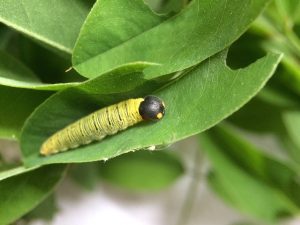
How is your garden fluttering? That’s the question butterfly gardeners ask themselves. But to get to the flutters, you need the creeping, crawling stage. Instead of reaching for a pesticide at any signs of holes in foliage, search for butterfly or moth caterpillars. Perhaps soon you will be out at night searching with a flashlight for elusive caterpillars because many will feed at night to outwit would-be predators. You never know where butterfly gardening will take you.
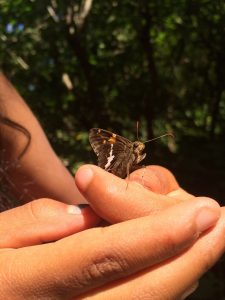
Creating a garden that is a sanctuary for butterflies is not too difficult. One of the most important things to do is completely avoid pesticides, even organic ones. Butterflies are insects and therefore are susceptible to these poisons. This guide will give you a list of nectar plants that many butterflies like, but it is certainly not exhaustive. Nectar plants are where a lot of butterfly gardeners start and, unfortunately, stop.
Two things are even more important than nectar plants. Those are host plants or the caterpillar food plants and your fall and spring clean-up practices. Many species of butterfly caterpillars are fairly restrictive in their diets and can only eat certain plants. In order to really attract butterflies and observe a full range of behaviors, you need to have the host plants in your yard. A little known fact about many of our butterflies (and for most of our other insects) is that they overwinter in one form or another; some may spend the winter as eggs, or as caterpillars, as pupae, or even as adults. Each species has a different strategy for surviving winter so that it continue its life cycle the next spring.
As I continue to add native plants, and the years go by, more and more interesting butterflies find my yard, which, to me, really speaks to the impact native plants have. I have found two species that have used plants not listed as their typical host plants, so it’s interesting to see what will visit my yard and what plants it uses. For instance, this year I raised Wild Indigo Duskywings on Canadian Milkvetch, and Nessus Sphinx Moths on Prairie Sundrops. Most of the butterflies listed below are ones that I have seen here in the Oak Park area (exceptions: Milbert’s Tortoiseshell, White Admirals). Over time, it would be wonderful to see Grey Hairstreaks in the region; reportedly, they do well in urban areas, and with all of the rudbeckia and helianthus in the area, perhaps Silvery Checkerspots will show up.
Important nectar plants:
- Milkweeds (Asclepias species)
- Eupatorium species
- Liatris
- Echinacea species (straight native)
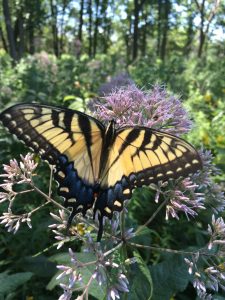
- Anise Hyssop
- Phlox
- Native Asters
- Goldenrods
- Monarda (Bee Balm)
- Native Spireas (Meadowsweet, Steeplebush)
- Coreopsis
- Viburnums
- Native sunflowers (Helianthus, but be careful, some species very aggressive)
- Silphiums
- Alliums
- Rudbeckias (Brown-eyed Susans)
- Lawn “weeds”
A list of host plants and their butterflies. In parentheses, we’ve listed in what stage they overwinter:
| Host Plant Name | Butterfly |
| 1.Golden Alexander, Dill, Italian Parsley, Fennel, Rue (all in the carrot family | 1. Eastern Black Swallowtail (pupa, attached to a stem) |
|
2.Milkweeds: Rose (or Swamp) Milkweed (Asclepias incarnata) Butterflyweed (Asclepias tuberosa); Asclepias sullivantii (Prairie Milkweed) are favorites | 2.Monarchs (migrate away to Mexico) |
|
3. Pearly Everlasting, Prairy Pussytoes, Prairie Sage (eggs will definitely be laid on Pussytoes here, but you can raise the caterpillars on Prairie Sage, a much more prolific and larger plant.) | 3.American Lady (does not survive winters here; has to recolonize its range each summer) |
|
4. Mallows, hollyhocks, thistles | 4.Painted Lady (like the American Lady) |
|
5. Native asters (New-england Aster, Aromatic Aster, Hairy Aster, Frost Aster) | 5.Pearl Crescent (overwinters as a caterpillar) |
| 6.Violets | 6.Fritillaries (overwinter as young caterpillars at the base of the host plant) |
| 7. Lupines and other native legumes (Showy Tick Trefoil, Round-headed Bush Clover) |
7.Blues, Duskywings, Cloudywings (overwintering may depend on the species. E.g., Eastern-tailed Blue, caterpillar; Wild Indigo Duskywing, caterpillar, Northern Cloudywing, caterpillar) |
|
8. Plaintain, Ruellia, Snapdragon, Blue), Monkey flower (Mimulus ringens) | 8.Buckeye, (recolonizes range) |
|
9. Native Grasses (dropseed, little bluestem, tridens flavus, purple love grass, Big Bluestem, Switch Grass (Panicum) are important ones | 9. Skippers (many overwinter as larva); Eyed Browns, Wood Nymphs |
|
10. Nettles (False Nettles, skin-friendly) |
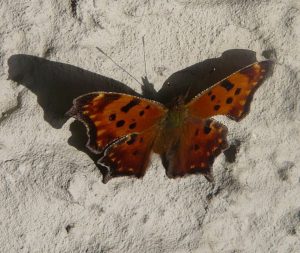
10.Red Admirals (recolonize range), Question Marks (adult overwinters), Eastern Comma (adult overwinters), Milbert’s Tortoishell (unlikely suburban visitor)
11. Pennsylvania Pellitory
11. Red Admirals (recolonize range) 12. Willows (Salix sp.)
12. Mourning Cloaks (adults overwinter), White Admirals, Red-spotted Purples (love Black Cherry), Viceroys (overwinter as caterpillars) 13. Aspens, Tulip Poplar, Magnolia, Black Cherry Tree
13.Tiger Swallowtails (overwinter as pupae; they use an assortment of trees) 14. Elms
14.Question Marks, Easter Comma, Mourning Cloak (overwinter as adults) 15.Hackberry
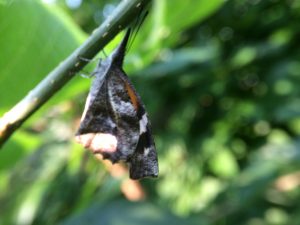
15.Hackberry Emperor (overwinters as caterpillar), Tawny Emperor (caterpillar), American Snout (recolonizes range) 16. Wafer Ash Tree (Ptelea trifoliata)
16. Giant Swallowtail ( will also eat Prickly Ash); (overwinters as chrysalis) 17. Wild Blue Indigo (Baptisia australis)
17. Silver-spotted Skipper (pupa overwinters), Wild Indigo Duskywing (caterpillar overwinters), some sulphurs (many sulphurs recolonize the range; Clouded Sulphur can spend the winter as a chrysalis (I raised one); but most sources say it overwinters as a caterpillar).
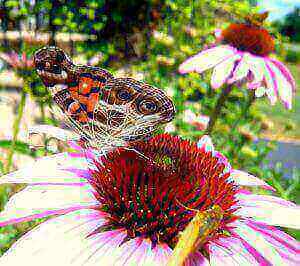
Butterfly-friendly gardening practices:
- Plant densely in drifts (energy efficient and protects them in all life stages from predators)
- Plant for blooms over the different seasons (don’t neglect spring and fall nectar plants)
- No pesticides
- Allow some weeds (unless you know for sure they aren’t a food plant); they can be handy nectar plants
- Very little fall and spring clean-up. Most butterflies overwinter as caterpillars or in chrysalises. They could be in leaf litter or on stems/twigs.
- If you do clean-up, try to inspect for chrysalises and caterpillars. Do as little as you can. Try to keep stems, etc in the garden (sometimes you can’t, so be it), but in general, try to keep as much material in your garden as you can. You can also compost debris in place by hiding it under foliage or in a spot to the back of the garden. Using this method might allow any surviving larvae to crawl back to the host plant and continue its life cycle. In the spring, they reawaken and complete their life cycles. Your soil will be healthier and so will your plants from the organic matter allowed to recycle back into the soil. For a guide about using mowing or burning in your garden, consult Xerces guide to Pollinator Habitat Management: http://www.xerces.org/pollinator-conservation-managing-habitat/ Though this is written for larger scale habitats, the principles are the same, and the methods can be downscaled for smaller residential gardens.
- Water if necessary (try to use natives) keep nectar production and keep plants hydrated. Rain barrels are handy. Caterpillars get their water from the plants.
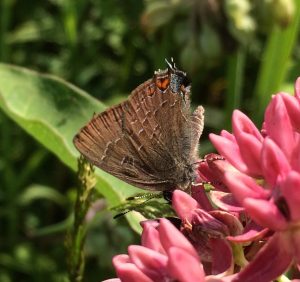
Gardening for these vulnerable creatures requires a little knowledge and perhaps readjusting or changing gardening habits, but with a little effort, we can contribute to the well-being of some of the most at risk creatures on earth; the effort is minimal and the repayment is huge. We are losing our butterfly populations because of loss of habitat, pesticide use, and predators and other parasitic insects that have been released to control undesirable moths and other crop pests. If we all just gave a little of our yards up for the butterflies, they might be able to make a rebound and survive for generations to come.
–Written and photos by Stephanie Walquist
(If your group would like a butterfly talk, email [email protected]. She discusses the many species that live in the area and what you can do to help them out.)
